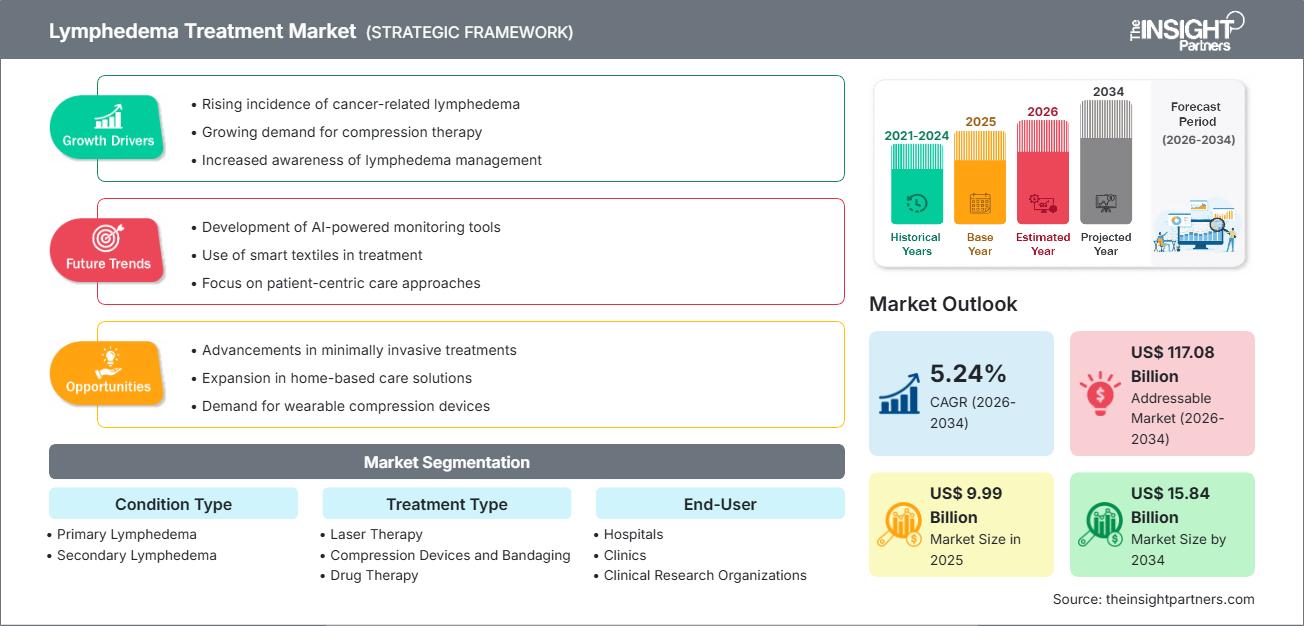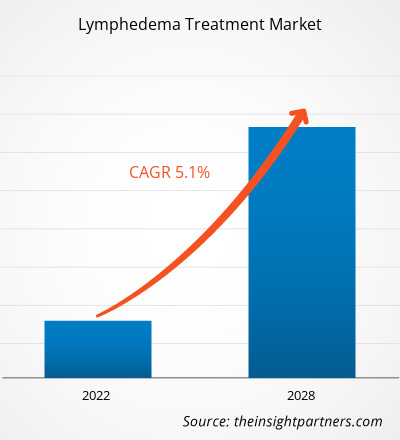Der Markt für die Behandlung von Lymphödemen wird bis 2034 voraussichtlich ein Volumen von 15,84 Milliarden US-Dollar erreichen, gegenüber 9,99 Milliarden US-Dollar im Jahr 2025. Es wird erwartet, dass der Markt im Zeitraum 2026–2034 eine durchschnittliche jährliche Wachstumsrate (CAGR) von 5,24 % verzeichnen wird.
Marktanalyse zur Behandlung von Lymphödemen
Der Markt für Lymphödemtherapien verzeichnet ein signifikantes Wachstum, vor allem aufgrund der weltweit steigenden Prävalenz von Lymphödemen und der zunehmenden Zahl von Krebsüberlebenden. Postoperative und strahleninduzierte Lymphödeme (sekundäre Lymphödeme) machen den Großteil der Fälle aus. Die Behandlung basiert weiterhin auf der Komplexen Physikalischen Entstauungstherapie (KPE), wobei Kompressionsstrümpfe und pneumatische Kompressionsgeräte die Grundlage der Therapie bilden. Technologische Fortschritte, darunter die Einführung intelligenter Kompressionssysteme, minimalinvasive Operationstechniken und Telemedizin zur Fernüberwachung, revolutionieren die Patientenversorgung und die Therapietreue. Die jüngsten positiven Änderungen bei der Kostenerstattung in wichtigen Märkten, wie beispielsweise die Übernahme der Kosten für Kompressionsstrümpfe durch Medicare in den USA, tragen ebenfalls maßgeblich zum Marktwachstum bei.
Marktübersicht zur Lymphödembehandlung
Das Lymphödem ist eine chronische Erkrankung, die durch eine abnorme Ansammlung von Lymphflüssigkeit gekennzeichnet ist und typischerweise Schwellungen in den Gliedmaßen verursacht. Ursache ist ein geschädigtes oder unzureichend funktionierendes Lymphsystem. Die Behandlung konzentriert sich auf die Linderung der Symptome und die Verhinderung eines Fortschreitens der Erkrankung, da es derzeit keine Heilung gibt. Zu den wichtigsten Therapien zählen die Kompressionstherapie (mit Kompressionsstrümpfen, Bandagen und Pumpen), die manuelle Lymphdrainage (MLD) und Bewegungstherapie. Ziel ist es, die Schwellung zu reduzieren und das Volumen der betroffenen Gliedmaße zu erhalten. Die zunehmende Verwendung moderner pneumatischer Kompressionsgeräte und die wachsende Verlagerung hin zur häuslichen Pflege sind wichtige Trends. Darüber hinaus werden die Forschungs- und Entwicklungsbemühungen im Bereich der medikamentösen Therapien und anspruchsvoller chirurgischer Eingriffe wie der lymphovenösen Anastomose (LVA) und des vaskularisierten Lymphknotentransfers (VLNT) intensiviert.
Passen Sie diesen Bericht Ihren Anforderungen an.
Sie erhalten eine kostenlose Anpassung aller Berichte – einschließlich Teilen dieses Berichts, Länderanalysen und Excel-Datenpaketen – sowie attraktive Angebote und Rabatte für Start-ups und Universitäten.
Markt für Lymphödembehandlung: Strategische Einblicke

-
Ermitteln Sie die wichtigsten Markttrends dieses Berichts.Diese KOSTENLOSE Probe beinhaltet eine Datenanalyse, die von Markttrends bis hin zu Schätzungen und Prognosen reicht.
Markttreiber und Chancen bei der Lymphödembehandlung
Markttreiber:
- Zunehmende globale Prävalenz von Lymphödemen und Krebs: Die steigende Zahl von Krebsfällen (insbesondere Brust-, Prostata- und Melanomkrebs) und die verbesserten Überlebensraten erhöhen direkt die Inzidenz von sekundären Lymphödemen und treiben damit die Nachfrage nach langfristigen Behandlungslösungen voran.
- Technologische Fortschritte bei den Behandlungsmodalitäten: Innovationen in der Kompressionstherapie, wie intelligente Kompressionskleidung mit Sensoren, IoT-verbundene pneumatische Kompressionspumpen und Verbesserungen der chirurgischen Techniken, erhöhen die Wirksamkeit und die Patientencompliance.
- Günstige regulatorische Rahmenbedingungen und Erstattungspolitik: Politische Änderungen, wie beispielsweise der US Lymphedema Treatment Act (LTA), der zur Kostenübernahme von Kompressionsbekleidung durch Medicare führte, reduzieren die Selbstbeteiligungskosten der Patienten und kurbeln die allgemeine Marktnachfrage an.
Marktchancen:
- Ausbau von Telemedizin und digitalen Gesundheitslösungen: Fernüberwachungsplattformen und die Integration digitaler Gesundheitslösungen bieten Skalierbarkeit, verbessern die Therapietreue der Patienten durch personalisiertes Feedback und ermöglichen ein besseres Management in unterversorgten Gebieten.
- Entwicklung neuartiger Arzneimitteltherapien: Die Forschung konzentriert sich auf pharmakologische Behandlungen (z. B. entzündungshemmende Mittel), die auf die zugrunde liegende Pathophysiologie (Entzündung, Fibrose) abzielen, und bietet damit ein hohes Wachstumspotenzial für die Entwicklung krankheitsmodifizierender Wirkstoffe.
- Minimalinvasive chirurgische Techniken: Fortschritte bei physiologischen chirurgischen Optionen wie der lymphovenösen Anastomose (LVA) und dem vaskularisierten Lymphknotentransfer (VLNT) bieten weniger invasive und potenziell kurative Optionen und treiben so spezialisierte Marktsegmente voran.
Marktbericht zur Lymphödembehandlung: Segmentierungsanalyse
Der Marktanteil der Lymphödem-Behandlung wird in verschiedenen Segmenten analysiert, um ein besseres Verständnis seiner Struktur, seines Wachstumspotenzials und der sich abzeichnenden Trends zu ermöglichen. Nachfolgend ist der in den meisten Branchenberichten verwendete Standard-Segmentierungsansatz dargestellt:
Nach Typ:
- Sekundäres Lymphödem
- Primäres Lymphödem
Nach Behandlungsart:
- Lasertherapie
- Kompressionsgeräte und Verbände
- Arzneimitteltherapie
- Physiologische Verfahren
Vom Endbenutzer:
- Krankenhäuser
- Kliniken
- Klinische Forschungsorganisationen
Nach Geographie:
- Nordamerika
- Europa
- Asien-Pazifik
- Süd- und Mittelamerika
- Naher Osten und Afrika
Markt für Lymphödembehandlung – Regionale Einblicke
Die regionalen Trends und Einflussfaktoren auf den Markt für Lymphödembehandlungen im gesamten Prognosezeitraum wurden von den Analysten von The Insight Partners eingehend erläutert. Dieser Abschnitt behandelt außerdem die Marktsegmente und die geografische Verteilung des Lymphödembehandlungsmarktes in Nordamerika, Europa, Asien-Pazifik, dem Nahen Osten und Afrika sowie Süd- und Mittelamerika.
Umfang des Marktberichts zur Lymphödembehandlung
| Berichtattribute | Details |
|---|---|
| Marktgröße im Jahr 2025 | 9,99 Milliarden US-Dollar |
| Marktgröße bis 2034 | 15,84 Milliarden US-Dollar |
| Globale durchschnittliche jährliche Wachstumsrate (2026 - 2034) | 5,24 % |
| Historische Daten | 2021-2024 |
| Prognosezeitraum | 2026–2034 |
| Abgedeckte Segmente |
Nach Zustandsart
|
| Abgedeckte Regionen und Länder |
Nordamerika
|
| Marktführer und wichtige Unternehmensprofile |
|
Marktdichte bei der Behandlung von Lymphödemen: Auswirkungen auf die Geschäftsdynamik verstehen
Der Markt für Lymphödembehandlungen wächst rasant, angetrieben durch die steigende Nachfrage der Endverbraucher. Gründe hierfür sind unter anderem sich wandelnde Verbraucherpräferenzen, technologische Fortschritte und ein wachsendes Bewusstsein für die Vorteile der Produkte. Mit steigender Nachfrage erweitern Unternehmen ihr Angebot, entwickeln innovative Lösungen, um den Bedürfnissen der Verbraucher gerecht zu werden, und nutzen neue Trends, was das Marktwachstum zusätzlich beflügelt.

- Überblick über die wichtigsten Akteure auf dem Markt für Lymphödembehandlung
Marktanteilsanalyse der Lymphödembehandlung nach Regionen
Nordamerika wird voraussichtlich den Markt für Lymphödemtherapie dominieren und den größten Marktanteil halten. Diese Dominanz beruht auf der hohen Prävalenz von krebsbedingtem Lymphödem, den hohen Gesundheitsausgaben, einer starken Erstattungspolitik (einschließlich des Lymphödemtherapiegesetzes) und der Präsenz führender Technologie- und Gerätehersteller.
Der asiatisch-pazifische Raum dürfte der am schnellsten wachsende regionale Markt sein. Dieses Wachstum ist auf die verbesserte Gesundheitsinfrastruktur, steigende verfügbare Einkommen und ein zunehmendes Bewusstsein für die Diagnose und Behandlung von Lymphödemen zurückzuführen, insbesondere in Schwellenländern wie China und Indien.
Nachfolgend eine Zusammenfassung der Marktanteile und Trends nach Regionen:
-
Nordamerika
- Marktanteil: Besitzt den größten Marktanteil, was auf einen großen Patientenstamm und eine fortschrittliche medizinische Infrastruktur zurückzuführen ist.
- Wichtigste Einflussfaktoren: Günstige Rahmenbedingungen für die Kostenerstattung (z. B. US Lymphedema Treatment Act), hohes Bewusstsein bei Ärzten und Patienten sowie die Präsenz großer Medizintechnikunternehmen.
- Trends: Rasche Verbreitung von hochentwickelten pneumatischen Kompressionsgeräten und zunehmende Investitionen in spezialisierte chirurgische Zentren.
-
Europa
- Marktanteil: Der zweitgrößte Markt, getrieben durch ein strukturiertes öffentliches Gesundheitssystem und standardisierte Lymphödem-Managementprotokolle.
- Wichtigste Einflussfaktoren: Hohes Krebsvorkommen und damit verbundenes Lymphödem, starker Fokus auf die komplexe physikalische Entstauungstherapie (KPE) und staatlich geförderte Forschung und Entwicklung für medizinische Geräte.
- Trends: Entwicklung innovativer, komfortabler und diskreter Kompressionsbekleidung; Fokus auf personalisierte medizinische Ansätze.
-
Asien-Pazifik
- Marktanteil: Der am schnellsten wachsende regionale Markt, angetrieben durch die Expansion des Social Commerce und intelligenter digitaler Ökosysteme in China, Indien und Südostasien.
- Wichtigste Einflussfaktoren: Steigende Gesundheitsausgaben, eine große Patientenpopulation, eine wachsende Zahl von Krankenhäusern und Fachkliniken, die Lymphödembehandlungen anbieten, und ein zunehmender Fokus auf Medizintourismus für spezialisierte Operationen.
- Trends: Verstärkte Nutzung erschwinglicher Diagnose- und Therapiegeräte; rasantes Wachstum bei Lösungen für das häusliche Pflegemanagement.
-
Süd- und Mittelamerika
- Marktanteil: Ein aufstrebender Markt mit allmählichem Wachstum.
- Wichtigste Einflussfaktoren: Verbesserung des Zugangs zur Gesundheitsversorgung und zunehmender Fokus auf das Management chronischer Krankheiten.
- Trends: Ausbau von Bildungs- und Sensibilisierungsinitiativen zum Thema Lymphödem, zunehmender Import und Einsatz globaler Kompressionstechnologien.
-
Naher Osten und Afrika
- Marktanteil: Aufstrebender Markt mit starkem Wachstumspotenzial, angeführt von Initiativen zur digitalen Transformation in den VAE und Saudi-Arabien.
- Wichtigste Einflussfaktoren: Steigende Investitionen in die Modernisierung der Gesundheitsinfrastruktur und ein zunehmender Fokus auf die Behandlung chronischer Erkrankungen, einschließlich krebsbedingter Lymphödeme.
- Trends: Integration internationaler Behandlungsleitlinien; Einführung technologisch fortschrittlicher Kompressionsgeräte.
Marktdichte bei der Behandlung von Lymphödemen: Auswirkungen auf die Geschäftsdynamik verstehen
Der Markt für Lymphödembehandlungen zeichnet sich durch einen starken Wettbewerb aus, der sich aus etablierten globalen Medizintechnikunternehmen und einer Reihe spezialisierter Firmen zusammensetzt, die sich auf Kompression und Lymphdrainage konzentrieren.
Die Wettbewerbsdynamik veranlasst die Anbieter, sich durch Folgendes zu differenzieren:
- Unternehmen investieren massiv in die Entwicklung intelligenter, sensorgestützter Kompressionskleidung und -pumpen, die die Therapietreue verbessern und den Therapiefortschritt des Patienten aus der Ferne überwachen.
- Anbieter gehen Kooperationen mit Krankenhäusern, Fachkliniken und onkologischen Zentren ein, um integrierte Behandlungspfade für Lymphödempatienten anzubieten – von der Diagnose bis zur Langzeitbetreuung.
- Es wird zunehmend Wert darauf gelegt, Geräte zu entwickeln, die leicht, tragbar, benutzerfreundlich und für die häusliche Pflege geeignet sind, um diese lebenslange Erkrankung effektiver zu bewältigen.
Chancen und strategische Schritte
- Für Unternehmen, die erfolgreich das erste wirksame Medikament entwickeln und vermarkten, das die mit Lymphödemen verbundenen Gewebeveränderungen stoppt oder umkehrt, ergeben sich bedeutende Chancen.
- Große Unternehmen übernehmen kleinere, innovative Startups, die sich auf Diagnostik, digitale Gesundheitsintegration oder neuartige chirurgische Instrumente spezialisieren, um ihr gesamtes Portfolio im Bereich der Lymphödembehandlung zu stärken.
- Unternehmen konzentrieren sich auf die Marktdurchdringung im asiatisch-pazifischen Raum und in Lateinamerika, um von den steigenden Gesundheitsausgaben und dem wachsenden Gesundheitsbewusstsein in diesen Regionen zu profitieren.
Die wichtigsten Unternehmen auf dem Markt für Lymphödembehandlung sind:
- Biokompressionssysteme
- Essity Medical Solutions
- L & R Gruppe
- SIGVARIS
- Taktile Medizin
- Smith + Neffe
- Thermo Tek
- Huntleigh Healthcare Limited.
- Physiopedia
Hinweis: Die oben aufgeführten Unternehmen sind nicht in einer bestimmten Reihenfolge geordnet.
Neuigkeiten und aktuelle Entwicklungen auf dem Markt für Lymphödembehandlungen
- Beispielsweise kündigte Tactile Systems Technology, Inc., ein Medizintechnikunternehmen, das Therapien für Menschen mit chronischen Erkrankungen anbietet, am 3. Juni 2025 die Präsentation neuer klinischer Daten auf der Jahrestagung der American Society of Clinical Oncology (ASCO) an, die signifikante klinische Vorteile und eine Verbesserung der Lebensqualität durch den Einsatz des Flexitouch Plus-Systems des Unternehmens im Vergleich zur Standardbehandlung bei der Behandlung von Patienten mit Lymphödemen im Zusammenhang mit Kopf-Hals-Tumoren belegen.
- Im Oktober 2024 gab Tactile Systems Technology, Inc., ein Medizintechnikunternehmen, das Therapien für Menschen mit chronischen Erkrankungen anbietet, bekannt, dass Nimbl, seine pneumatische Kompressionsplattform der nächsten Generation, ab sofort in den gesamten Vereinigten Staaten zur Behandlung von Lymphödemen der oberen Extremitäten erhältlich ist. Nimbl ist deutlich kleiner und leichter als Vorgängermodelle und eignet sich als Behandlungsoption für Patienten mit Lymphödemen der oberen und unteren Extremitäten, chronischen Ödemen, Veneninsuffizienz und Wundheilungsstörungen.
- Im Oktober 2021 gab Essity, ein weltweit führendes Hygiene- und Gesundheitsunternehmen, bekannt, dass es dem Boston Lymphatic Symposium (BLS), einer gemeinnützigen Organisation, die sich der Förderung des Kampfes gegen Lympherkrankungen und der Verbesserung der Gesundheitsversorgung von Patienten mit Lympherkrankungen durch Aufklärung, Bildung und Forschung widmet, einen JOBST® Lymphatic Research Grant zur Verfügung stellt.
Marktbericht zur Lymphödembehandlung: Abdeckung und Ergebnisse
Der Bericht „Marktgröße und Prognose für die Lymphödembehandlung (2021–2034)“ bietet eine detaillierte Analyse des Marktes, die folgende Bereiche abdeckt:
- Marktgröße und Prognose für die Lymphödembehandlung auf globaler, regionaler und Länderebene für alle wichtigen Marktsegmente, die im Rahmen des Berichts abgedeckt werden
- Trends im Markt für Lymphödembehandlungen sowie Marktdynamiken wie Treiber, Hemmnisse und wichtige Chancen
- Detaillierte PEST- und SWOT-Analyse
- Marktanalyse zur Behandlung von Lymphödemen: Wichtige Markttrends, globale und regionale Rahmenbedingungen, Hauptakteure, regulatorische Bestimmungen und aktuelle Marktentwicklungen
- Branchenlandschaft und Wettbewerbsanalyse mit Fokus auf Marktkonzentration, Heatmap-Analyse, führende Akteure und aktuelle Entwicklungen im Markt für Lymphödembehandlung. Ausführliche Unternehmensprofile.
- Historische Analyse (2 Jahre), Basisjahr, Prognose (7 Jahre) mit CAGR
- PEST- und SWOT-Analyse
- Marktgröße Wert/Volumen – Global, Regional, Land
- Branchen- und Wettbewerbslandschaft
- Excel-Datensatz
Aktuelle Berichte
Erfahrungsberichte
Grund zum Kauf
- Fundierte Entscheidungsfindung
- Marktdynamik verstehen
- Wettbewerbsanalyse
- Kundeneinblicke
- Marktprognosen
- Risikominimierung
- Strategische Planung
- Investitionsbegründung
- Identifizierung neuer Märkte
- Verbesserung von Marketingstrategien
- Steigerung der Betriebseffizienz
- Anpassung an regulatorische Trends






















 Kostenlose Probe anfordern für - Markt für Lymphödembehandlungen
Kostenlose Probe anfordern für - Markt für Lymphödembehandlungen